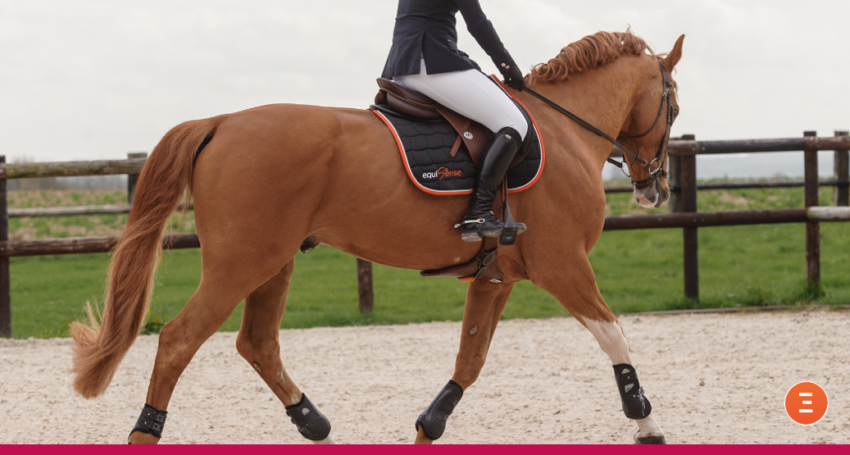
How to strengthen the hindquarter muscles of your horse
Is it also your great pride to see that your horse has well developed hindquarters? For me it is the ultimate result of good bodybuilding and the sign of a well done job. In this article, I’ll explain you here how to strengthen hindquarter muscles of your horse
After having written on the neck, the shoulders, the chest, the back and abs, all was left was the hindquarters. Let’s see together how to make your horse’s hindquarters well developed.
But, as usual, let’s take it step by step. There are a few things to know beforehand.
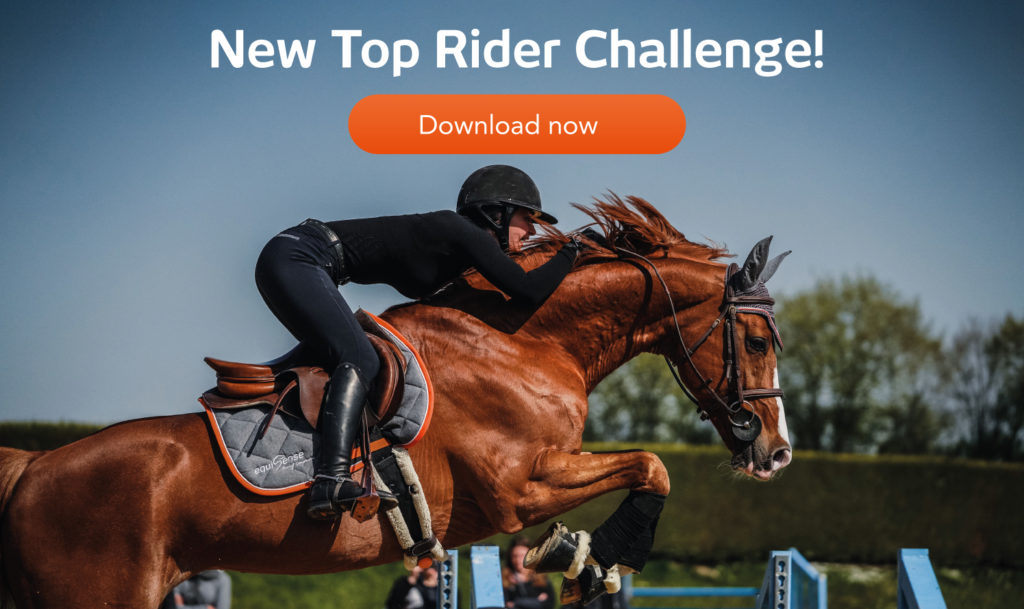
Table des matières
#1 – Small parallel between human and horse
Firstly, let’s start by doing a bit of anatomy, but comparing human and horse so that you understand fully.
As with the rest of their anatomy, humans and horses are very similar. The only thing here is that the proportions are very different and their pelvis is not oriented like ours because they are quadrupeds.
Thus, their hock actually corresponds to our heel. And their stifle is actually our knee.
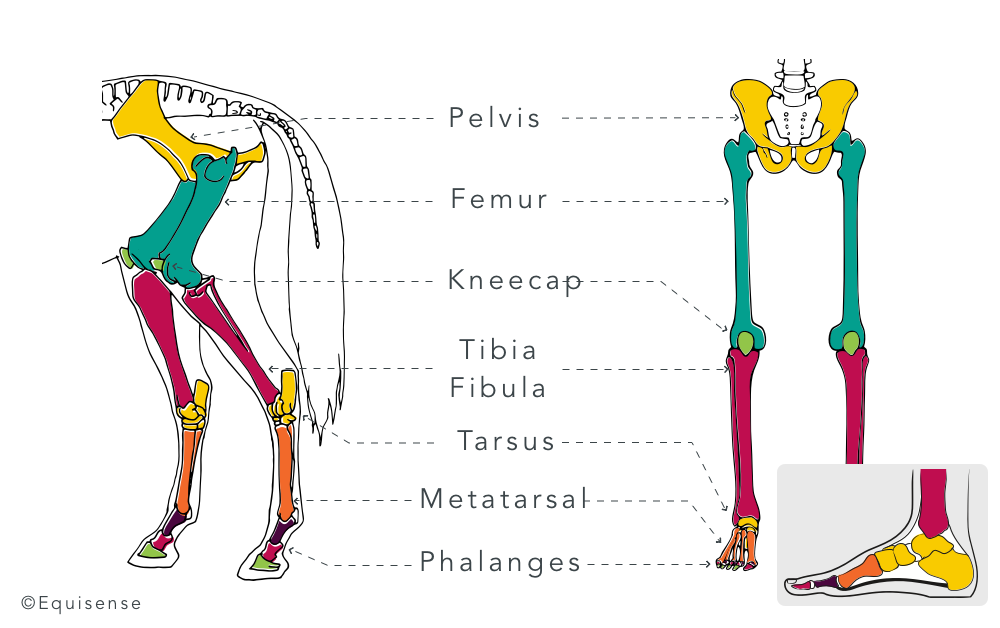
However, the horse has a particularity that you must know:
#2 – Reciprocal Apparatus, a specificity of the horse
The horse has an anatomical peculiarity that it is interesting to explain here. It is called “The reciprocal apparatus”.
In fact, the reciprocal apparatus is a ligament and tendon system that strengthens the joints of the stifle, hock and fetlock. These three joints are dependent on each other thanks to these two structures: the peroneus tertius muscle that connects the lower femur to the middle of the cannon bone. And the superficial flexor of the finger that goes from the femur to the pastern, passing through the hock.
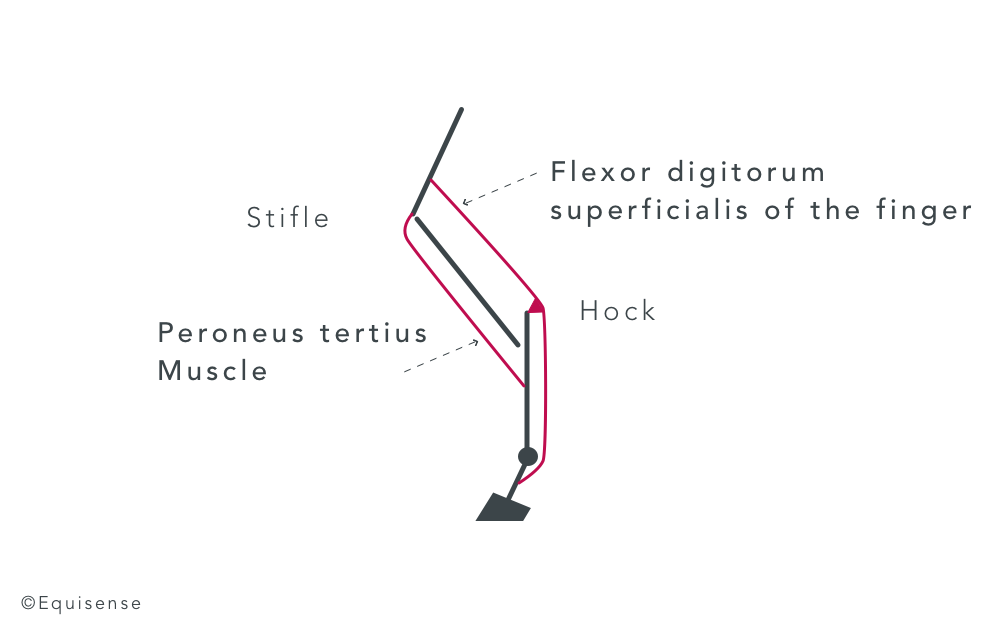
As they are rather rigid structures, when the stifle is bent, the peroneus tertius muscle will mechanically drive the cannon bone and thus the hock will flex. And as the hock will flex, it will drive the pastern backwards to flex the stifle.
And it’s the same in extension!
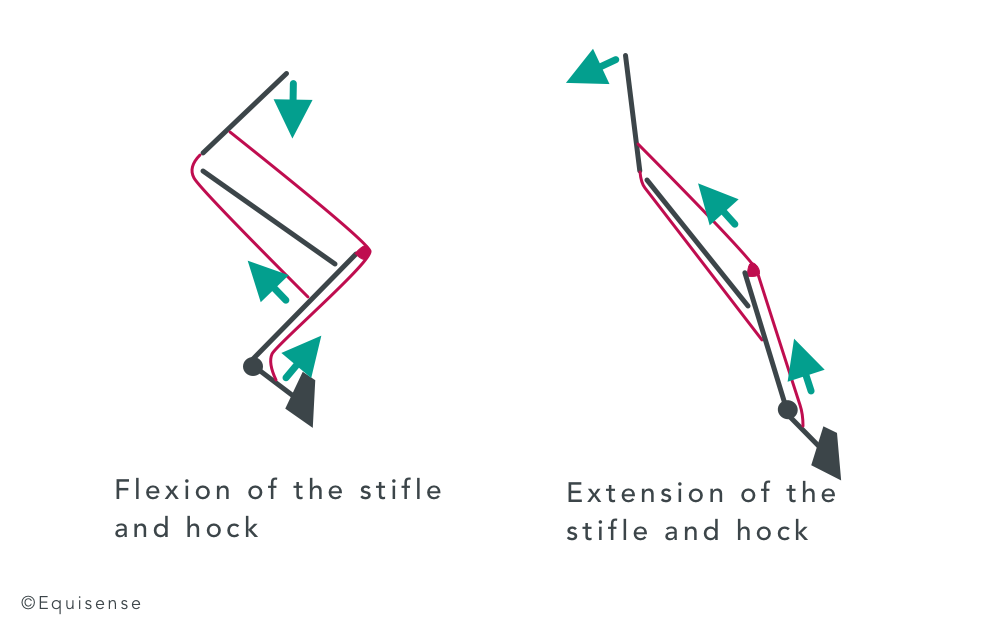
Imagine, it’s as if by bending the knee, the tip of your foot was raised and your toes automatically bended.
So, no need to look for the muscles under the hock, there are none! Whereas we have muscles located at the level of the foot sole to move the toes.
What is it for?
In fact it is the evidence of the adaptation of the horse to the race and therefore to the high speed gaits. It allows the horse to mobilize the entire lower joints of the hind leg solely through the muscles of the thigh. It is therefore a fabulous energy saver necessary to go fast.
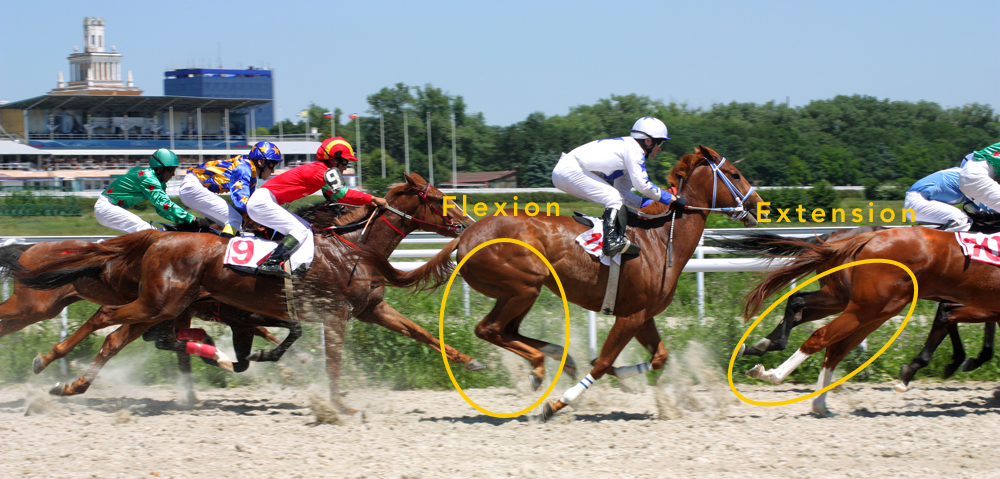
#3 – Why do some horses have pointier or flatter buttocks than others?
I didn’t talk much about conformation in the previous articles, but here I find that the conformation of the hindquarters is much more noticeable than the shoulder for example. So it deserves a few words so that you can quickly understand why your horse has a flat buttock, or on the contrary, why he has a pointed croup.
In fact, these differences in appearance are due to the relative conformation between the sacral vertebrae, pelvis and femur. Depending on the length and inclination of these different parts, the appearance and locomotor qualities will not be the same.
In fact, these different conformations have an impact on the potential of the horses and the difficulty you will have to muscle them, but not really on the way to do it. The exercises remain the same.
I will discuss the importance of conformation in a future article. For now, let’s focus on how to strengthen the hindquarter muscles!
#4 – The muscles of the horse’s hindquarters
Here is the important part. The muscles of the hindquarters are actually divided into 3 groups:
- hip or pelvic muscles
- thigh muscles
- leg muscles
Let’s see in detail these three groups and how to strengthen them!
Hip Muscles
These are the muscles that mobilize the femur. The most visible of them are those that shape the croup. These are the gluteus medius and superficial gluteal muscles. They are attached to the top of the lumbar vertebrae and end at the top of the femur. They thus make it possible to put the hip in extension (to make the hind legs go backwards).

“In the horse, [the gluteus medius] is the most effective extender of the body and the most decisive agent in propulsion and relaxation.”
Jean Marie Denoix
The buttocks also have the function of being abductors. That is to say that they stretch the hind leg outwards.
For hip flexion, it is the Iliopsoas muscle that takes care of it! Do you remember it? We talked about it in the article about back and abs muscles!
“[…] It is the most effective agent of hip flexion. It is therefore the ultimate hind leg engagement muscle“ Jean-Marie Denoix
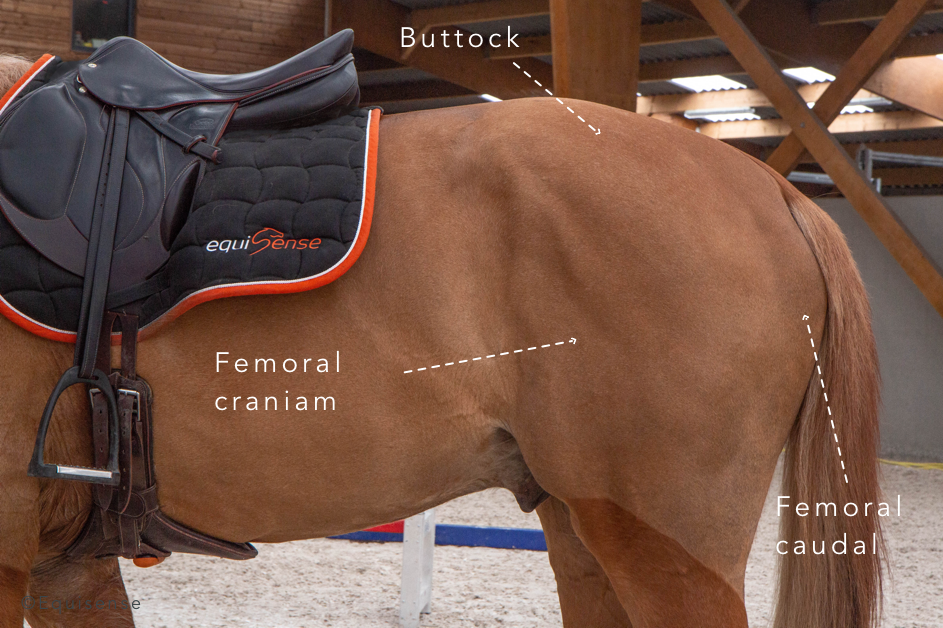
Thigh Muscles
They are called femoral muscles because they are around the … shin ! Obviously it’s a joke. They are around the femur of course!
They are further divided into 3 groups: cranial / caudal / medial femorals.
The cranial femorals are therefore in front of the femur. They are used to flex the hip and to put the stifle in extension. Among them is the Femoral Quadriceps.
The caudal femorals are behind the femur. These are the ones that are well drawn in horses that are a little thin. They form two masses behind the buttocks. Depending on the moment of the stride, their function will be different. Simply put, they mobilize the stifle and the hip.
Finally, the medial femorals are on the inside of the thigh. They play the role of adductor and thus bring the hind leg inwards!
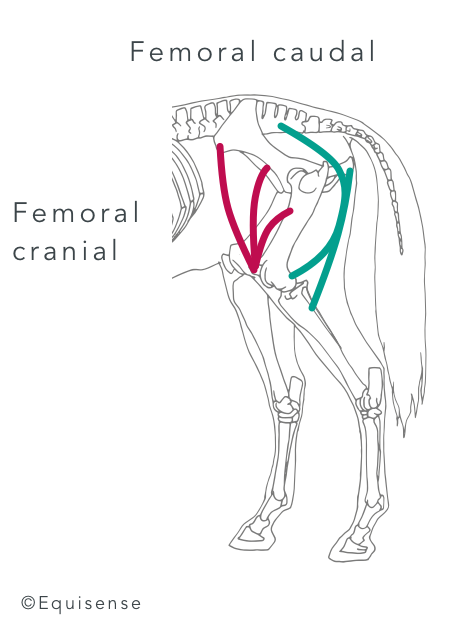
Leg Muscles
They are the ones who are around the shin. They end in long tendons which are attached on the hock itself, or on the top of the cannon bone, or even below the pastern, on the phalanges.
Their role will therefore be to bend or extend the hock and the fetlock.
I will pass a little bit quickly on their intervention in the different movements.
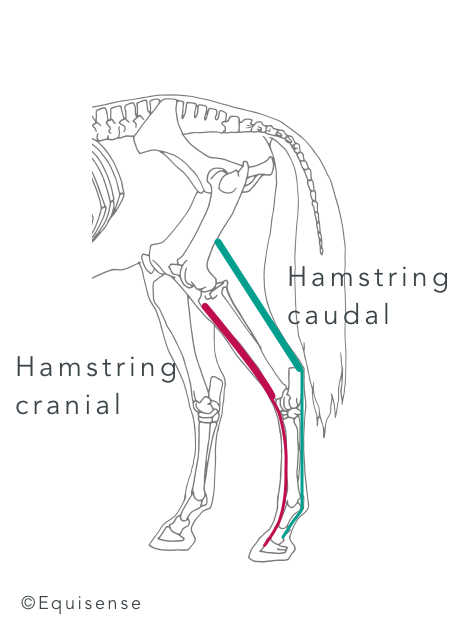
#5 exercises to strengthen your horse’s hindquarters
Now that you know all the muscles and their roles, let’s see how to develop them. Here are 5 exercises to strengthen your horse’s hindquarters.
All these exercises can be found on our Equisense mobile application! It is free, don’t hesitate to download it on your mobile phone.


Exercise #1 – Working on slopes
And yes, as for us, working uphill and downhill makes for incredible buttocks. You don’t need complicated exercises to strengthen the hindquarter muscles of your horse.
When going uphill, the horse has to use a lot more force to propel themselves forward. It is therefore a very good exercise to develop in concentric contraction the buttocks, especially the gluteus medius (the largest), and the caudal femorals.
Exercise #2 – Reinback
Reinback, as I have already mentioned in the article on back and abdominal muscles, is a very good exercise to strengthen the Iliopsoas muscle. So, you will have understood it, to improve the engagement of the hind legs, which is The principle is that it makes it work “in fixed point inversion”.
When the horse moves forward, the fixed point of the Iliopsoas is the vertebrae and ilium (the pelvis). The mobile point is the femur. It will pull the femur forward. When the horse moves backwards, it is the opposite! Indeed, the fixed point becomes the femur, the mobile point becomes the spine and the pelvis. The muscle will therefore have to pull the horse’s body backwards, which is much more difficult.
The principle of fixed point inversion
To picture this exercise, imagine you are lying on your stomach at the end of your bed, your arms hanging in the air and mimic the movement of push-ups with your arms. Too easy! Very roughly, in this case the fixed point is your body and the mobile point is your arms. Now really do push-ups. Now it’s a little less easy… because you’ve inverted the fixed point (your hands) and the moving point (your body). Reinback is the same principle.
Body-Building
In addition to the work of the iliopsoas, reinback allows the caudal femorals and the gluteus medius to work in concentric contraction since they will allow the hind leg to retract (the fact that the hind leg is going backwards)!
Also, you can combine reinback with a fast trot start to make it a “plyometrics” exercise. It works the explosive power of the muscles by quickly linking concentric and eccentric contractions. So it’s a great exercise to strengthen the hindquarter muscles.
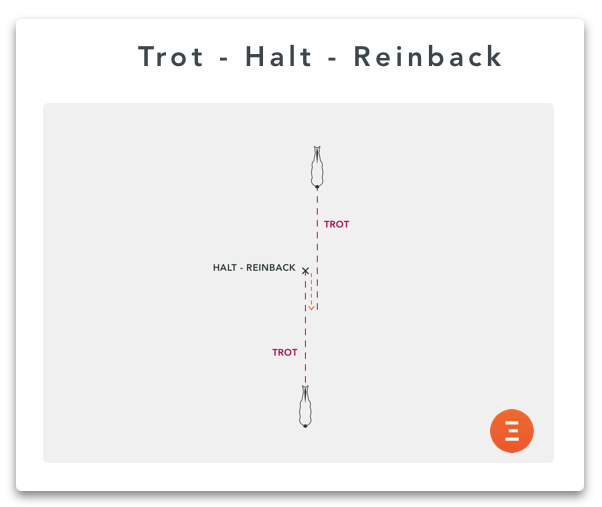
Reining back trains the psoas-iliac, the femoral caudals and the gluteus medius in a very intense way! Even more when followed by an energetic start at trot.
Exercise #3 – Jumping at walk
The jumps at the step are extraordinary to muscle the buttocks as well. Compared to jumps at trot or canter, jumps at walk have the advantage that they require a lot more strength because of the lack of speed when approaching. It is therefore a very good exercise to develop explosivity and therefore to gain muscle volume.
To do this, go on a small obstacle at walk. The obstacle should be really small at the start, then make it higher as your horse understands the exercise. Be extremely flexible in your hands (almost do it with loose reins). The jump will likely be quite strong. Consequently, don’t hesitate to hold the mane at the beginning.
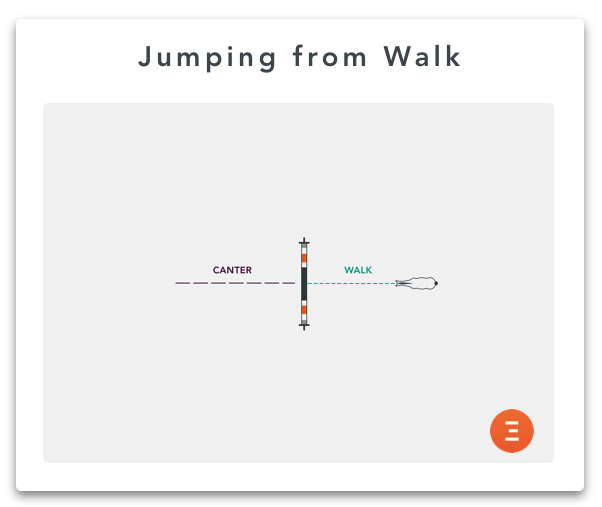
The whole of the muscles of the hindquarters is solicited to make the horse jump and to propel them. It is an extremely complete exercise. It will also allow horses that rush to learn to jump slowly, gradually restoring their self-confidence. Horses that don’t break down their jumps enough will also find it a great advantage.
Jumping from walk helps developing muscles of the buttocks in volume and makes the horse gain in explosiveness!
Exercise #4 – Raised staggered poles
The raised poles in all three gaits actually accentuate the normal movement of the limbs during the stride.
The hind legs will therefore “move back more”, making the gluteus medius, femoral and caudal leg muscles work. They will bend harder and will have to go forwards, working the iliopsoas, cranial femorals and cranial leg muscles. This all together will allow to strengthen the hindquarter muscles.
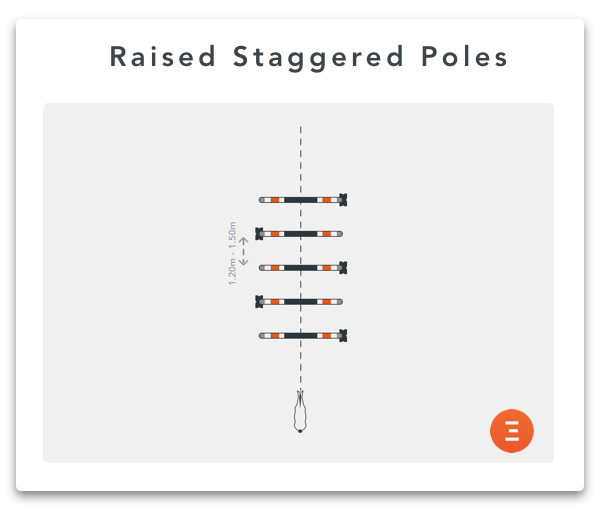
It is a very good routine exercise to do almost without moderation! Raised staggered poles help accentuating the movement of the limbs.The limbs have to flex more, move more forward, and more backwards. It’s great for the hindquarters in general.
Exercise #5 – Lateral Movements
Finally, lateral movements are perfect for working on adduction (pulling the leg inwards) and abduction (moving the hind leg outwards). Therefore, they will allow the development of the medial femorals (those in the inner thigh), which will act as adductors. And the gluteus medius accompanied by some cranial femorals which play the role of abductors!
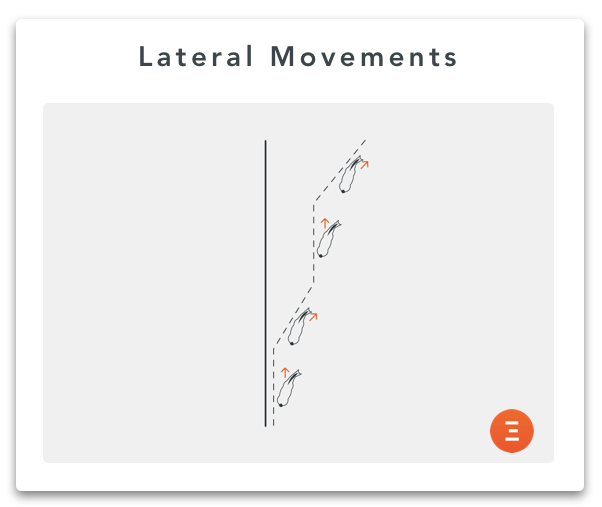
Lateral movements are great to strengthen the buttocks. Indeed, they will develop the muscles of the inside of the thigh.
Not all lateral movements make the muscles work in the same way. However, all of them are good for a complete training!
I refer you to the article that deals in depth with this subject for more information: 7 reasons to train lateral movements everyday
Here are the exercises you can do to strengthen the hindquarter muscles of your horse. Send us pictures when your horses have a “bulging butt”!
See you soon for a next article
Camille Saute
Scientific Director at Equisense
Sources
J.-M. Denoix, Biomécanique et gymnastique du cheval. Paris, France: Vigot, 2014.
Courbette : ©Alain Laurioux, IFCE
Photo de couverture : ©Nathalie Hupin – Equisense